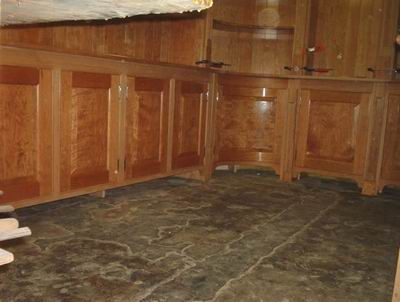Ripping Stock Straight
Shop machinery and techniques for ripping straight stock with glue-joint quality edges. April 16, 2010
Question
I donít understand how people can rip lumber without joining. When Iím ripping rail/style I rip and join, rip and join, rip and join, etc but this method is time consuming. However every piece of lumber is perfect. I like straight line ripping machines but how does the lumber come out straight after many times of ripping without jointing?
Forum Responses
(Cabinetmaking Forum)
From contributor M:
A straight line rip saw makes it more possible. Itís still not like a jointer, but you can get a pretty good edge right off the saw.
From contributor M:
If you only use a ripsaw Iíve found that the only joints it would be good for is paint grade. The joint will be strong enough but for face frames youíre going to have a lot of sanding to do so you should go ahead and use a joiner.
From contributor V:
You can save a lot of time by using a table saw to straighten rough boards. I keep a 1"x 6" x 12' board with straight and parallel edges in the shop for the purpose. I keep a few others at shorter lengths as well. Put the concave edge of the crooked board against the straight one and set the saw fence so as to take a whisper off the narrowest point of the subject board. Hold the two boards tightly together as you run them through the saw. It helps a great deal to use a cart or other device at the same height as the saw top to support the work in front of the saw.
This method gets your initial straight edge to begin ripping parts off of. Depending on how straight the further rippings stay, it is sometimes possible to go straight from the saw to the planner to machine the saw marks off of the edges. If jointer perfection is required, this method still saves the time it takes straightening long crooked boards with several jointer passes. Straighten first with the saw and then refine with a single jointer pass.
From contributor I:
Another option is to purchase your lumber hit/miss planed and straight line ripped one edge. The stock will have been ripped on a straight line rip saw and you have a straight edge to put against the fence. Cutting to length before re-ripping will also take care of any slight sidebend after straight line rip.
From contributor P:
1. It's joint, then rip.
2. The quality of the cut is not super important if you're running the pieces through the shaper. Do your sticking and profiling and/or edge sanding the edges of a finished door.
From contributor Y:
I too use a separate board. I have an 8' piece of plywood with an adjustable fence on it for varying widths of lumber and on that fence I have a pair of toggle clamps to hold it in place. It saves a lot of time getting an initial edge. I then take it to the jointer for final tweaking. After that if I see movement in the board as I am cutting it I will re-joint otherwise I just rip the stock wide and joint each piece one last time before final sizing. For a 2-1/4 stile or rail I will rip it to 2-3/4, joint, then rip to 2-3/8 before adding the profile.
From contributor Y:
What I meant was that I rip the board to 2-3/4, joint, run the profiles then rip to 2-3/8 giving me 1/8 waste for final sizing of the door after glue up.
From contributor A:
1. Rough cross but into lengths less than five feet.
2. Rough ripped +1/8-1/4" in width (often it is worth it to throw the board through the jointer to get a straight edge to start with).
3. Plane the parts.
4. Joint the edges of all of the pieces.
5. Rip the edges of the rails.
6. Cut for length.
7. Run the stile cut on a sizing shaper table to get exact width and it saves the previous ripping step.
From contributor L:
If any of you have a slightly larger shop a SL rip saw is well worth it. If the board starts to show curve just take a shave to straighten and keep going. A good glue line rip blade produces very little saw mark. Rather than jointing or planing the edges after sawing setup a shaper with feed and run to an outside fence. This allows you to climb cut those nasty boards if needed. Make a set of gage blocks for each width you use and you can always have the fence in just the right spot. The shaper never snipes a board either. PS the rip saw gives great glue joints and is probably faster than a table saw and for sure faster than a jointer.
From contributor R:
I like to plane my ff and door stock to final thickness, all four sides. It does have to be straight first however, for that I either use a joiner or a straight-line jig for the table saw.
From contributor R:
It just goes to show you all the trouble people put themselves thru by not having good quality machinery. I had a jointer once, total waste of space and time. Spend the money buy a Altendorf or Martin and quit screwing with it .
